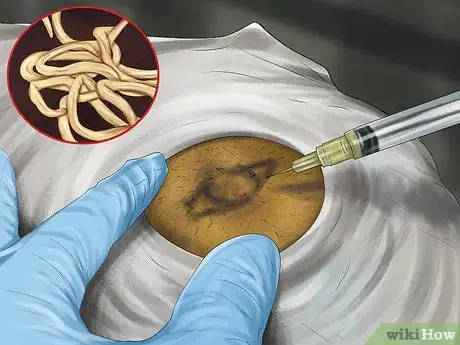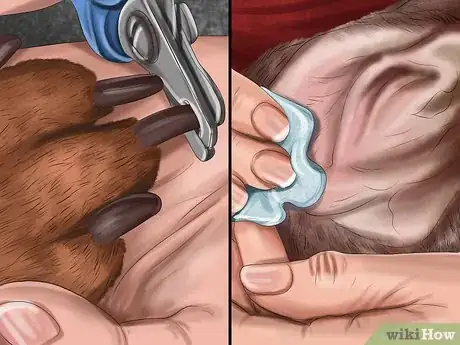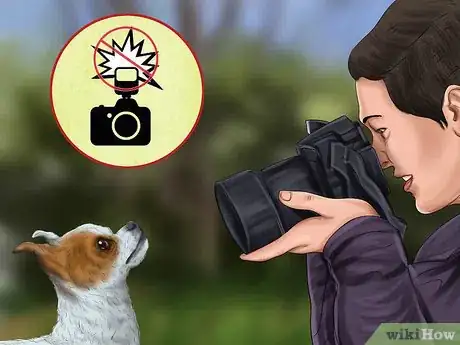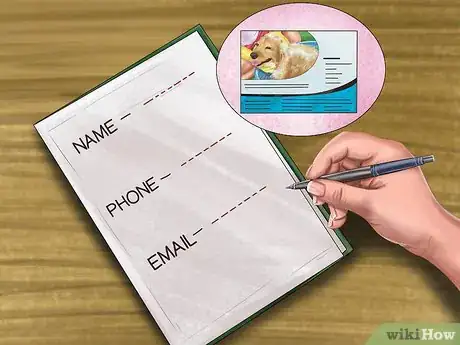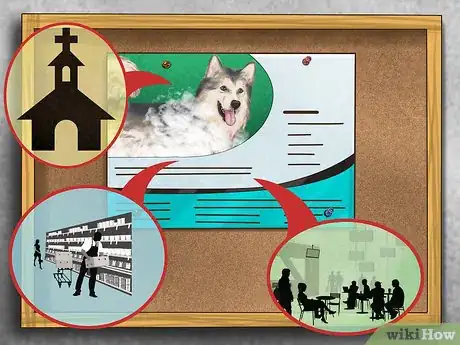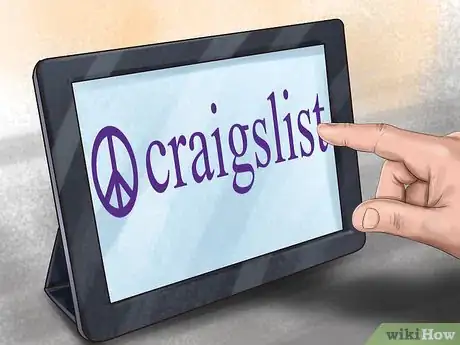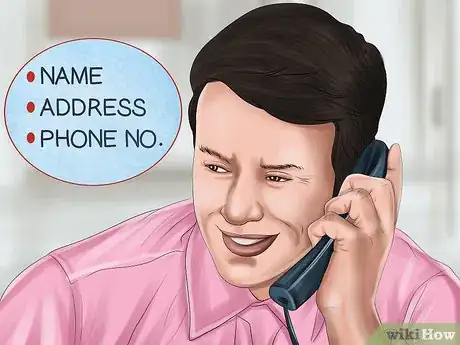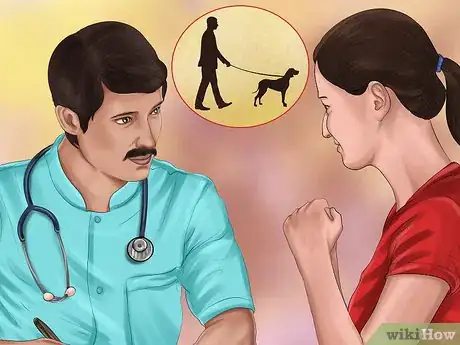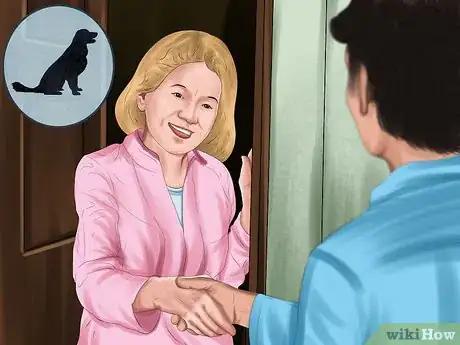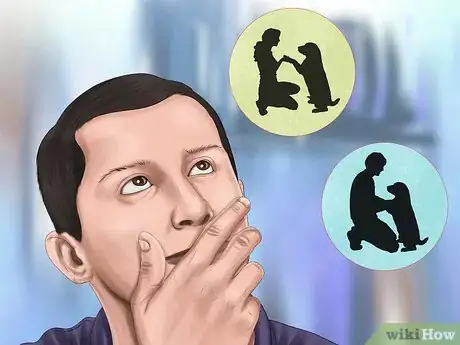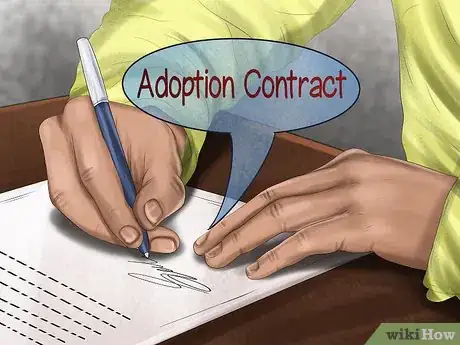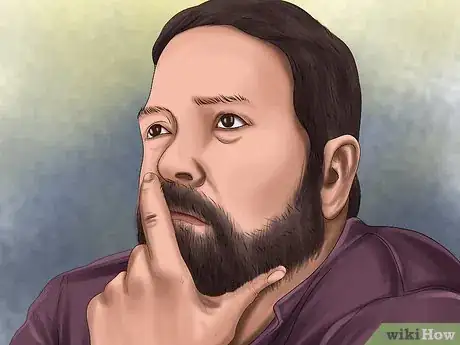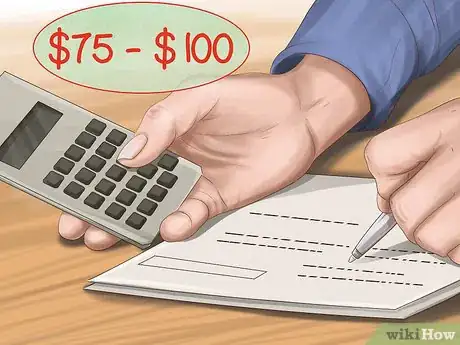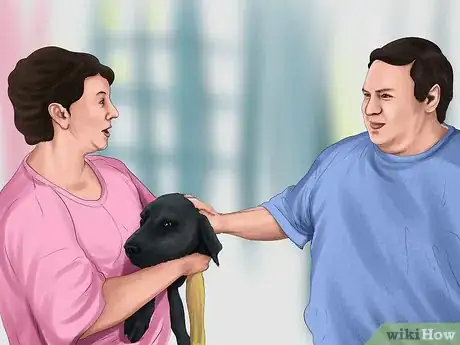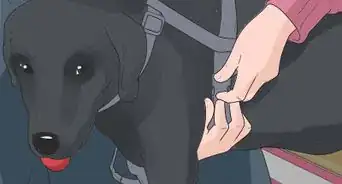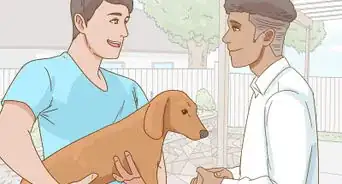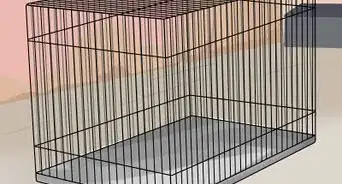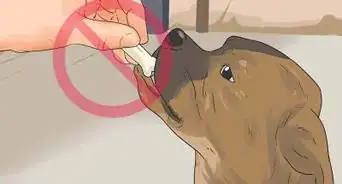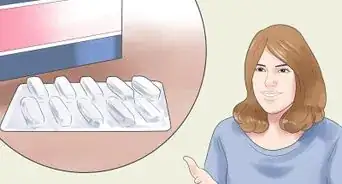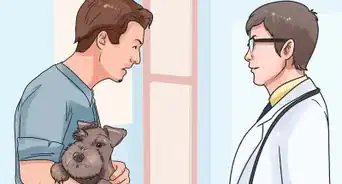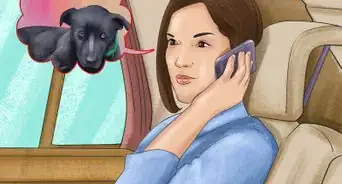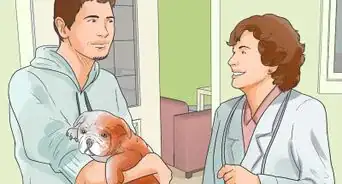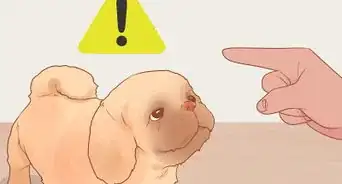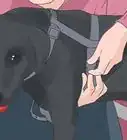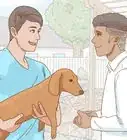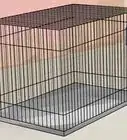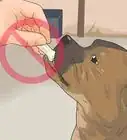This article was co-authored by Beverly Ulbrich. Beverly Ulbrich is a Dog Behaviorist and Trainer and the Founder of The Pooch Coach, a private dog training business based in the San Francisco Bay Area. She is a Certified CGC (Canine Good Citizen) Evaluator by the American Kennel Club and has served on the Board of Directors for the American Humane Association and Rocket Dog Rescue. She has been voted the best private dog trainer in the San Francisco Bay Area 4 times by SF Chronicle and by Bay Woof, and she has won 4 "Top Dog Blog" awards. She has also been featured on TV as a dog behavior expert. Beverly has over 18 years of dog behavior training experience and specializes in dog aggression and anxiety training. She has a Master of Business Administration from Santa Clara University and a BS from Rutgers University.
This article has been viewed 15,517 times.
For various reasons (behavioral problems, change in owner's work schedule, etc.), older dogs sometimes need to be re homed. Re homing an older dog can be challenging, though, because of the dog's age and the possibility of costly health problems.[1] Fortunately, because older pets are usually calmer and better trained than puppies or younger dogs, they can be wonderful additions to a family.[2] If you are looking to re home your older dog, prepare your dog for the process, seek out prospective new owners, and follow general re homing tips.
Steps
Preparing Your Dog for Re Homing
-
1Take your dog to your vet. Your older dog will have a better chance of being re homed if it is as healthy as possible. Your vet can make sure your dog is up to date on its vaccinations and is negative for heartworm disease and intestinal parasites.
- If your dog has a chronic disease that is being managed with medication, your vet can ensure the medication is still effectively control the disease.
- Obtain a copy of your dog's medical records so you can have this information on hand when you talk with prospective owners.
- A prospective owner may not want to take on health problems that have not been treated or managed well.[3]
- If your vet detects a new health problem in your dog, start treating that problem before starting the re homing process.
-
2Groom your dog. Your older dog will need to be at its best when you start the re homing process. When you start advertising your dog and introducing it to prospective owners, you will want your dog looking its best. Take your dog to a groomer or groom your dog at home:Advertisement
-
3Photograph your dog. It's important to take a good picture of your dog. Even though your dog is older, a great picture can make the re homing process a little bit easier by showing off your dog's best physical features. To take a high-quality picture:
- Wait until your dog is relaxed. You don't want your dog looking anxious or nervous in the picture.
- Have your dog look directly into the camera.
- Turn off the flash so your dog's eyes don't look red in the picture.
Advertising Your Dog
-
1Create a flyer of your dog. A well-designed color flyer can attract many prospective new owners. Taking the time to make a high quality, informative flyer can help you re home your older dog. Include information about your dog's overall health, likes, and dislikes.[4]
- Also, include information about your dog's physical appearance, positive personality traits (warm, friendly, etc), spay/neuter status, and any limitations (not good with cats or children).
- Place your contact information on the flyer (name, phone number, email address). For your personal safety, do not include your home address on the flyer.
- Don't forget to proofread your flyer. Spelling or grammatical mistakes could hurt your chances of re homing your older dog.
-
2Place flyers in your area. The more you can get the word out about your older dog needing a new home, the better. Place copies of the flyer on bulletin boards in churches, grocery stores, and community centers. You can also put flyers in libraries and coffee shops.[5]
- Veterinary offices and pet supply stores are other great locations for flyers.
-
3Advertise online and in print. In addition to posting flyers throughout your area, place ads about your dog on the internet and in your local newspaper. Many newspapers have a specific classified area for pet adoptions.[6] Also, pet rescue groups may allow you to post your ad on their website for free or for a small donation.
- If you place an ad in the newspaper, consider placing it in Sunday's paper, when more people are likely to read the newspaper.
- If you advertise online, use caution when placing your ad on sites like Craig's list. People looking to adopt a dog through Craig's list may not have your dog's best interests at heart.
-
4Talk with people. Word-of-mouth advertising can also work well for re homing your older dog. Talk with your friends, family, and coworkers to get the word about your older dog needing a new home.[7] If you take your dog to a dog park, talk with other dog owners while you are at the park.
- When you talk with people, make sure they know how to contact you in case they are interested, or they know someone who is interested, in adopting your older dog.
Screening Prospective Owners
-
1Ask questions when people contact you. You've had your dog for a long time and have a developed a special bond with it. You want to make sure it goes to someone who will love and care for it in the way it deserves. Therefore, be very selective when choosing your dog's next owner.[8] When people contact you, have a list of questions ready to ask them:
- What is your name, address, and phone number?
- Do you rent or own a home? If you rent, does your landlord accept pets?
- Do you have children? If so, how many and how old are they?
- Have you ever owned a dog before?
- Do you currently have pets? If so, how many and what types?
-
2Ask for references. If a prospective owner currently has pets, consider talking to their vets. Their vets can tell you how the owner cares for their current pets, which would indicate how well they would care for your older dog.[9]
- Caring for an older dog can be a big responsibility. You want to be sure your dog's next owner understands what it takes to care for a dog, especially one that is up in age.
-
3Schedule home visits. Visit the homes of the prospective owners who impressed you over the phone. Home visits will allow you to see what type of environment your dog could be living in, and observe how your dog reacts to the prospective owner and their house. These visits can also be a time for you to ask more questions.
- Schedule multiple home visits. During the first visit, your dog may be nervous and stay close to you. During the next few visits, your dog will likely relax a bit and interact more with the prospective owner.[10]
- As you talk with owner, pay close attention to your dog. If your dog isn't warming up to the home or the owner after a few visits, then that living situation may not be right for it.
-
4Select an owner. Take time to decide which prospective owner will be best for your dog. If you or your dog felt uncomfortable with someone, do not feel bad about no longer considering them. Make the decision based on what will be best for your older dog.
- Contact the owner you selected and begin moving forward with the adoption process.
-
5Sign an adoption contract. When you've selected an owner, do not just hand your dog over to that owner. Have them sign a contract to formalize the adoption. Fortunately, you don't have to come up a contract from scratch. The website http://www.aforeverhome.org/forms/sample-adoption-contract/ has a sample contract you can use to draft your own contract.
- An adoption contract, like other contracts, is legally binding.[11] Make sure both you and the new owner understand and agree to all terms in the contract before signing it.
- Because it may be at least several weeks before you can successfully re home your dog, develop the contract as you search for and screen prospective owners.
Following General Re Homing Tips
-
1Be patient. Re homing an older dog isn't easy. Because most people looking for dogs want puppies or young dogs, it will probably take you longer to find a new home for your older dog. It may take a month for longer before you find someone who wants an older dog.
-
2Set an adoption fee. Do not advertise your dog as 'free to a good home.' This can attract many people who will not have your dog's best interests at heart. Instead, set an adoption fee ($75 to $100) to help cover advertising and veterinary costs.[12] The people willing to pay the fee will likely be willing to take on the cost of dog ownership.
-
3Remain available after the adoption. After your older dog has been re homed, keep an open line of contact with the new owner in case they have questions about caring for your dog. However, resist the temptation to visit your dog often. Your dog will need to adjust to its new owner and will not be able to do so if you visit frequently.
Expert Q&A
-
QuestionHow do I find a good home for my dog?
 Beverly UlbrichBeverly Ulbrich is a Dog Behaviorist and Trainer and the Founder of The Pooch Coach, a private dog training business based in the San Francisco Bay Area. She is a Certified CGC (Canine Good Citizen) Evaluator by the American Kennel Club and has served on the Board of Directors for the American Humane Association and Rocket Dog Rescue. She has been voted the best private dog trainer in the San Francisco Bay Area 4 times by SF Chronicle and by Bay Woof, and she has won 4 "Top Dog Blog" awards. She has also been featured on TV as a dog behavior expert. Beverly has over 18 years of dog behavior training experience and specializes in dog aggression and anxiety training. She has a Master of Business Administration from Santa Clara University and a BS from Rutgers University.
Beverly UlbrichBeverly Ulbrich is a Dog Behaviorist and Trainer and the Founder of The Pooch Coach, a private dog training business based in the San Francisco Bay Area. She is a Certified CGC (Canine Good Citizen) Evaluator by the American Kennel Club and has served on the Board of Directors for the American Humane Association and Rocket Dog Rescue. She has been voted the best private dog trainer in the San Francisco Bay Area 4 times by SF Chronicle and by Bay Woof, and she has won 4 "Top Dog Blog" awards. She has also been featured on TV as a dog behavior expert. Beverly has over 18 years of dog behavior training experience and specializes in dog aggression and anxiety training. She has a Master of Business Administration from Santa Clara University and a BS from Rutgers University.
Dog Behaviorist & Trainer Do your due diligence—choose someone that you know, or find someone who can vouch for them. It also helps if you see that they have another dog that's really friendly.
Do your due diligence—choose someone that you know, or find someone who can vouch for them. It also helps if you see that they have another dog that's really friendly. -
QuestionWhat's the fastest way to rehome a dog?
 Beverly UlbrichBeverly Ulbrich is a Dog Behaviorist and Trainer and the Founder of The Pooch Coach, a private dog training business based in the San Francisco Bay Area. She is a Certified CGC (Canine Good Citizen) Evaluator by the American Kennel Club and has served on the Board of Directors for the American Humane Association and Rocket Dog Rescue. She has been voted the best private dog trainer in the San Francisco Bay Area 4 times by SF Chronicle and by Bay Woof, and she has won 4 "Top Dog Blog" awards. She has also been featured on TV as a dog behavior expert. Beverly has over 18 years of dog behavior training experience and specializes in dog aggression and anxiety training. She has a Master of Business Administration from Santa Clara University and a BS from Rutgers University.
Beverly UlbrichBeverly Ulbrich is a Dog Behaviorist and Trainer and the Founder of The Pooch Coach, a private dog training business based in the San Francisco Bay Area. She is a Certified CGC (Canine Good Citizen) Evaluator by the American Kennel Club and has served on the Board of Directors for the American Humane Association and Rocket Dog Rescue. She has been voted the best private dog trainer in the San Francisco Bay Area 4 times by SF Chronicle and by Bay Woof, and she has won 4 "Top Dog Blog" awards. She has also been featured on TV as a dog behavior expert. Beverly has over 18 years of dog behavior training experience and specializes in dog aggression and anxiety training. She has a Master of Business Administration from Santa Clara University and a BS from Rutgers University.
Dog Behaviorist & Trainer If you don't have time to research potential owners, go through a rescue group. They require people to fill out forms before they can adopt an animal, and they often do house checks to make sure there's a safe area for the dog.
If you don't have time to research potential owners, go through a rescue group. They require people to fill out forms before they can adopt an animal, and they often do house checks to make sure there's a safe area for the dog.
Warnings
- Animal shelters and rescue groups are frequently overburdened and cannot always provide the level of care and attention older dogs need to stay healthy.⧼thumbs_response⧽
- Because older dogs don't always adjust well to change, being re homed can be very stressful for older dogs.⧼thumbs_response⧽
References
- ↑ http://www.petadoptionnetwork.org/?page_id=635
- ↑ https://www.dogstrust.org.uk/help-advice/factsheets-downloads/0203_dgt_6pp%20dl%20older%20dog%20hr%20(2).pdf
- ↑ http://www.petadoptionnetwork.org/?page_id=635
- ↑ http://www.adoptaseniorpet.com/contact/rehoming-your-pet
- ↑ http://www.adoptaseniorpet.com/contact/rehoming-your-pet
- ↑ http://www.petadoptionnetwork.org/?page_id=635
- ↑ http://www.adoptaseniorpet.com/contact/rehoming-your-pet
- ↑ Beverly Ulbrich. Dog Behaviorist & Trainer. Expert Interview. 12 February 2021.
- ↑ http://www.adoptaseniorpet.com/contact/rehoming-your-pet
About This Article
If you need to rehome an older dog, start by taking a few high-quality photographs to use in advertisements. Next, create informative flyers and post advertisements online that include pictures, health information, temperament, the adoption fee, and why the dog is being rehomed. When interested parties start contacting you, screen them by asking questions about their living situation, pet history, and anything else you feel is important. You can even visit prospective owners before making a final decision to ensure your older dog is going to a good home. For more helpful tips on advertising adoption for your older dog, read on!
